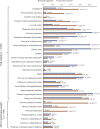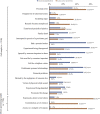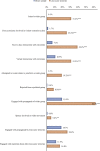The Base Rate Study: Developing Base Rates for Risk Factors and Indicators for Engagement in Violent Extremism
- PMID: 31999360
- PMCID: PMC7318282
- DOI: 10.1111/1556-4029.14282
The Base Rate Study: Developing Base Rates for Risk Factors and Indicators for Engagement in Violent Extremism
Abstract
Improvements have been made in identifying the prevalence of risk factors/indicators for violent extremism. A consistent problem is the lack of base rates. How to develop base rates is of equal concern. This study has two aims: (i) compare two methods for developing base rates; the Unmatched Count Technique (UCT) and direct questioning, (ii) generate base rates in a general population sample and compare these to a sample of lone-actor terrorists (n = 125). We surveyed 2108 subjects from the general population. Participants were recruited from an online access panel and randomly assigned to one of three conditions; direct survey, control, or UCT. Survey items were based on a lone-actor terrorist codebook developed from the wider literature. Direct questioning was more suitable under our study conditions where UCT resulted in deflation effects. Comparing the base rates identified a number of significant differences: (i) lone-actor terrorists demonstrated propensity indicators related to a cognitive susceptibility, and a crime- and/or violence-supportive morality more often; the general sample demonstrated protective factors more often, (ii) lone-actor terrorists demonstrated situational indicators related to a crime- and/or violence-supportive morality more often, whereas the general sample experienced situational stressors more often, (iii) lone-actor terrorists demonstrated indicators related to exposure to extremism more often. Results suggest there are measurable differences in the prevalence of risk factors between lone-actor terrorists and the general population. However, no single factor "predicts" violent extremism. This bears implications for our understanding of the interrelation of risk and protective factors, and for the risk assessment of violent extremism.
Keywords: Prolific; base rates; lone-actor terrorism; online survey methods; risk assessment; terrorism; threat assessment; unmatched count technique; violent extremism.
© 2020 The Authors. Journal of Forensic Sciences published by Wiley Periodicals, Inc. on behalf of American Academy of Forensic Sciences.
Figures



Similar articles
-
Similar crimes, similar behaviors? Comparing lone-actor terrorists and public mass murderers.J Forensic Sci. 2021 Sep;66(5):1797-1804. doi: 10.1111/1556-4029.14793. Epub 2021 Jul 13. J Forensic Sci. 2021. PMID: 34254683
-
Lone Actor Terrorist Attack Planning and Preparation: A Data-Driven Analysis.J Forensic Sci. 2018 Jul;63(4):1191-1200. doi: 10.1111/1556-4029.13676. Epub 2017 Oct 23. J Forensic Sci. 2018. PMID: 29059713
-
Bombing alone: tracing the motivations and antecedent behaviors of lone-actor terrorists,J Forensic Sci. 2014 Mar;59(2):425-35. doi: 10.1111/1556-4029.12312. Epub 2013 Dec 6. J Forensic Sci. 2014. PMID: 24313297 Free PMC article.
-
Psychopathology in female offenders of terrorism and violent extremism: a systematic review.Front Psychiatry. 2023 Jun 27;14:1123243. doi: 10.3389/fpsyt.2023.1123243. eCollection 2023. Front Psychiatry. 2023. PMID: 37441140 Free PMC article.
-
[Mental illness and terrorism].Lakartidningen. 2017 Nov 9;114:EWLS. Lakartidningen. 2017. PMID: 29292925 Review. Swedish.
Cited by
-
Contextualizing involvement in terrorist violence by considering non-significant findings: Using null results and temporal perspectives to better understand radicalization outcomes.PLoS One. 2023 Nov 10;18(11):e0292941. doi: 10.1371/journal.pone.0292941. eCollection 2023. PLoS One. 2023. PMID: 37948411 Free PMC article.
-
Is radicalization a family issue? A systematic review of family-related risk and protective factors, consequences, and interventions against radicalization.Campbell Syst Rev. 2022 Jul 20;18(3):e1266. doi: 10.1002/cl2.1266. eCollection 2022 Sep. Campbell Syst Rev. 2022. PMID: 36913228 Free PMC article. Review.
-
What are the effects of different elements of media on radicalization outcomes? A systematic review.Campbell Syst Rev. 2022 Jun 8;18(2):e1244. doi: 10.1002/cl2.1244. eCollection 2022 Jun. Campbell Syst Rev. 2022. Update in: Campbell Syst Rev. 2021 Mar 05;17(1):e1148. doi: 10.1002/cl2.1148. PMID: 36913204 Free PMC article. Updated. Review.
-
[Experiences of dangerous situations in psychiatry and psychotherapy involving patients with extremist attitudes].Nervenarzt. 2023 May;94(5):408-416. doi: 10.1007/s00115-023-01469-5. Epub 2023 Mar 22. Nervenarzt. 2023. PMID: 36947217 Free PMC article. German.
-
Cognitive and behavioral radicalization: A systematic review of the putative risk and protective factors.Campbell Syst Rev. 2021 Jul 20;17(3):e1174. doi: 10.1002/cl2.1174. eCollection 2021 Sep. Campbell Syst Rev. 2021. PMID: 37133261 Free PMC article. Review.
References
-
- Schuurman B. Research on terrorism, 2007–2016: a review of data, methods, and authorship. Terror Polit Violence 2018:1–16.
-
- Desmarais SL, Simons‐Rudolph J, Brugh CS, Schilling E, Hoggan C. The state of scientific knowledge regarding factors associated with terrorism. J Threat Assess Manag 2017;4(4):180–209.
-
- Logan C, Lloyd M. Violent extremism: a comparison of approaches to assessing and managing risk. Legal Criminol Psychol 2019;24(1):141–61.
-
- Gill P. Toward a scientific approach to identifying and understanding indicators of radicalization and terrorist intent: eight key problems. J Threat Assess Manag 2015;2(3–4):187–91.
-
- Scurich N, John RS. Prescriptive approaches to communicating the risk of violence in actuarial risk assessment. Psychol Public Policy Law 2012;18(1):50–78.
MeSH terms
Grants and funding
LinkOut - more resources
Full Text Sources

